Lewisham, Kent, London
Up to 1834
In 1612, a house in Rushey Green was bequeathed to the Lewisham Parish Vestry for the relief of the poor. In 1764, parish records include a payment to Elizabeth Everard for five days' cleaning and mending of old clothes at the workhouse.
A parliamentary report of 1777 recorded parish workhouses in operation at Lewisham (for up to 25 inmates), Eltham (36), and Plumstead (45).
By 1814, the Lewisham workhouse premises at that time had become run-down and overcrowded so Lewisham obtained a Local Act of Parliament and appointed a Board of Guardians to organise poor relief. A new workhouse was erected in 1817, at the west side of Lewisham Road (later named Lewisham High Street), opposite Lewisham Park.
After 1834
The Lewisham Poor Law Union was formed on 28th November, 1836. Its operation was overseen by an elected Board of Guardians, 20 in number, representing representing its 7 constituent parishes as follows (figures in brackets indicate numbers of Guardians if more than one): Charlton next Woolwich (3), Eltham (3), Kidbroke, Lee (2), Lewisham (7), Mottingham, and Plumstead (3). The population falling within the Union at the 1831 census had been 18,426 — ranging from Mottingham (population 124) to Lewisham itself (9,659). The average annual poor-rate expenditure for the period 1834-36 had been £6,580 or 7s.2d. per head of the population.
The new Lewisham Board of Guardians decided to continue using the existing workhouse site, but its capacity of 186 was insufficient for the new Union. In 1837, the Poor Law Commissioners authorized the sum of £2,000 for alteration and enlargement. An early addition was that of cholera wards at the rear of the workhouse. The workhouse location and layout is shown on the 1860s map below. The main building at this date (shown highlighted in grey) had a frontage along Lewisham High Street with a long east-west wing to the rear and, from that, a smaller wing running to the south. The map also shows an "infant poor house" at the south-east of the main workhouse — presumably where infants and young children were accommodated.
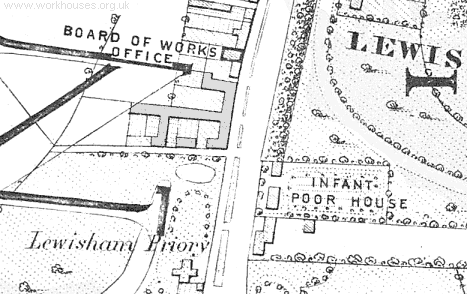
Lewisham workhouse site, early 1860s.
In August 1865, Lewisham was the subject of one of a series of reports in medical journal The Lancet investigating conditions in London's workhouse infirmaries. As shown by the extracts below, Lewisham got a middling report, good in some respects, but much room for improvement in others. It is interesting to note that the workhouse predominantly accommodated the elderly, infirm and sick and appears largely to have been performing the role of a pauper hospital.
The union consists of seven parishes, with a population of 65,757 persons. The house, which is the property of the parish, is rented by the union at an annual charge of 350l., and was built for 300 inmates. The drainage is good ; the water-supply (from a well in the yard) defective. On the occasion of our visit there were 160 in residence ; and we were most obligingly shown over the house by Mr Want, the master, who appeared to us fully alive to his duties and responsibilities.
With the exception of the infection wards, four in number, in a detached building in the yard. there is no proper classification. Sick, infirm, and able-bodied — so-called at least, but we saw none in the entire house-were placed in close approximation. The sandwich fashion obtained, showing at least a complete want of organization and method.
The sick wards are seven in number: three for males, containing thirty-three beds, and allowing all average of 494 cubic feet per bed ; and four for females, containing thirty-nine beds, and allowing an average of 489 cubic feet ; besides four infection wards, containing twenty-two beds, with an average cubic space of 539 feet. There can be no doubt that, were these wards filled, the accommodation would be very deficient (though not seriously below the Poor-law Board's standard), and that the infectious cases in particular would be very badly off with only 539 cubic feet per bed. Practically this need not be of much consequence, as the house, which was built for 300, is never filled, and, at the time of our visit, contained, as we have stated, only 180 inmates; but in several wards the neglect of the most ordinary precautions made the atmosphere very foul. In many respects the wards are commendable. There is great attention paid to cleanliness of floors, walls, windows, &c.; there are pictures, texts, and suitable books in plenty ; and the bed furniture is sufficient and good. But there is one cruel piece of neglect - viz., the excessive shortness of the iron bedsteads, which are only 5 ft. long by 2 ft. 5 in. wide ! Towels, and the other appliances for washing the sick, are well arranged and well supplied.
In the presence of much that was deserving of praise in the style of management, we were surprised to find in several wards a total absence of water-closets, and to be told that the inmates bad to pass along an entire range of buildings to obtain the accommodation. [We are glad to say that the guardians have, since our visit, removed this objection to a great extent, and made other valuable improvements at considerable cost, especially with regard to the baths, &c. Our labour has not been in vain!] There was the same absence of lavatories and baths ; indeed, no individual ward had its own exclusive closet, lavatory, or bath. There is but one, and that a movable, bath in the house, and no hot-water apparatus ; so that a bath being wanted, water must be specially heated and carried to the ward in which it is required, and this to the annoyance and discomfort of the rest of the ward-patients.
The condition of the patients — chiefly persons advanced in life, and suffering from the diseases of old age — appeared very satisfactory ; and when spoken to, many of them, in language as emphatic as truthful, expressed gratitude and thankfulness for what was done for them. We saw a good supply of macintoshes, and other appliances indicating more than usual regard for the comfort and well-being of the poor. Cards over the beds, giving name, age, disease, and treatment, have not yet reached this suburb ; we trust, however, that the medical officer will accept our suggestion, and resort to them as a valuable help in hospital management.
The care— domestic, at least — of the sick (and we saw few in the house who could very properly be removed from this dependent category) is committed to the matron (the wife of the master), one paid nurse, and thirteen pauper helps. The whole of the latter appeared to us admirable objects of one's sympathy, but without exception disqualified, physically and morally, for the responsible duties of nursing the sick-fit rather to be nursed themselves; the paid nurse, after many years' faithful service, justly entitled to a pension ; consequently, in our judgment, the only reliable aid left to carry out the directions of the medical officer is the matron, whose other duties as mistress of the house must consume her time and exhaust her energies. Hence it must follow that the sick and infirm are wanting in proper care and hospital appliances. We would therefore suggest the appointment of properly qualified and well-trained nurses to meet the wants of the different classes of sick and infirm ; all of whom might act under the direction of the matron, herself guided by the medical officer.
The various kinds of food and the methods of cooking are in most instances good and commendable. We tasted both the beef and mutton, which were well dressed and wholesome ; also the potatoes, bread, ale, and porter, all of which were really good; and the quantity served out to each individual was abundant. For the really sick, however; we would suggest roast meat occasionally, instead of boiled. To boil meat is to abstract a large amount of its nutritive qualities, and, unless the broth is drunk with the meat, the recipient is thus deprived of what really belongs to him. At very little additional cost roast meat might be given in turn with boiled. Beef-tea (and really good we found it), arrowroot, milk, and extra tea are given out when asked for, without need of a medical order : a practice which we commend very strongly, and which we should be glad to see introduced as a common practice into all our workhouse infirmaries.
The medical officer, Mr. Hugh Stott, who is also surgeon to the district of Lewisham, is expected to visit the house at least four times a week, and daily when summoned. He supplies, all the drugs except cod-liver oil and quinine, and compounds for both in-and-out-patients, receiving for the whole of these duties about 105l. per annum. On the books we found about ninety patients in March, and sixty-seven in May. One case of scarlet fever was being treated in the infection wards, which are in many of their relations good. The number of midwifery cases in the house averages about eight in the year, which are attended by the paid nurse - nominally, however, by the medical officer, and for which he is paid at the rate of 10s. 6d. per case.
The inferences we arrived at respecting the medical officer are that he has almost, if not practically altogether, unlimited control over all the arrangements for the sick ; that the guardians are really most liberal, and, if well managed, may be induced to do whatever is for the good of the inmates, guided by the medical officer. The latter gentleman can order a liberal diet, and any and every appliance that may be needed for the sick ; and he can also ask for any change in the arrangements which his experience suggests as desirable, with a good prospect of obtaining his request. Consequently, if the most enlightened principles of hospital treatment which are now accepted in the profession are not carried out, we must suppose that the blame rests chiefly with the medical officer. It is true that his salary is utterly inadequate, and his whole position a false one; but this has nothing to do with the obligation to urge on the guardians improvements which are of vital importance to the sick.
As already stated, the type of diseases which prevail at Lewisham Union is chiefly characteristic of old age and declining powers : chronic cough, paralysis, and sore legs, with some few cases of phthisis, include nearly all. We carefully examined the medical records, and could find no trace of any epidemic. Formerly skin diseases prevailed in the house, when it was crowded with children ; it was then remarked that all children who came into the house contracted a form of scabies, that treatment did little good, but that on sending the children away into the country the disease almost immediately disappeared. At present there are no children kept here, and the disease has never appeared in the adults.
The mortality of 1863 was 35 ; that of 1864 was 45 — a high death-rate, which, however, depends chiefly on the accidental circumstance that many inmates enter the house in a dying condition.
The details we have given justify, we believe, the position which we gave to Lewisham in our General Report — as capable, with certain important modifications, of developing into a really good and well-conducted hospital. The grounds for this hope are the facts of its desirable situation and the composition of its board of guardians ; for the latter, we are convinced, are truly liberal in disposition, and where they err, do so in ignorance. We trust that they will accept the following suggestions for indispensable reforms:
- The wards require additional light and ventilation in several instances.
- Closets, lavatories, and baths, with a copious water-supply, are needed for every individual ward.
- Rigorous classification of cases ought to be adopted.
- A proper staff of paid and trained nurses is required.
- Finally - and this is the most important thing of all, — the guardians must break through the degrading traditions according to which they arrange the status and pay of the medical officer. When that official shall be relieved of the improper burden of supplying and of dispensing drugs-shall be decently paid, and encouraged to assume the grave and honourable responsibilities of a regular hospital officer, as he should be, there is little fear but that he will speak his mind freely to the guardians, and by his scientific advice save them from the scandal of ruling over a workhouse infirmary which, though good in some respects, has some deficiencies which must appear little less than barbarous at the present day. when everything connected with the knowledge of hygienic laws is assuming so great an importance and so extensive a development.
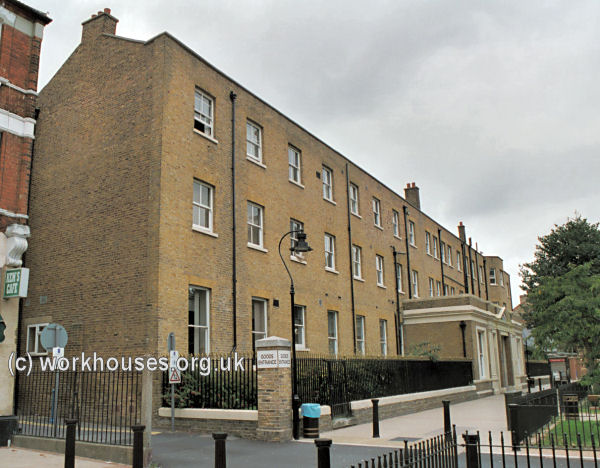
Lewisham workhouse from the south-east, 2001.
© Peter Higginbotham.
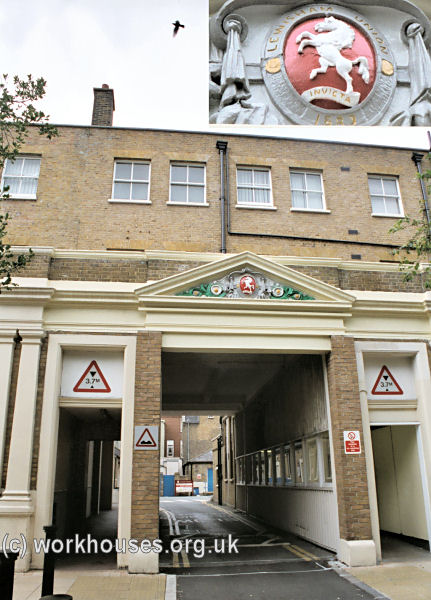
Lewisham workhouse from the east, 2001.
© Peter Higginbotham.
In 1868, the parishes of Charlton, Kidbrooke and Plumstead became part of the new Woolwich Union. In 1887, Mottingham transferred to the Bromley Union. In 1905, Lewisham and Lee became united as the civil parish of Lewisham.
Following acquisitions of land adjacent to the workhouse in 1877 and 1882, the site expanded northwards. New buildings were erected between 1882 and 1885, and in 1892-4, a separate infirmary building was erected to the north of the workhouse.
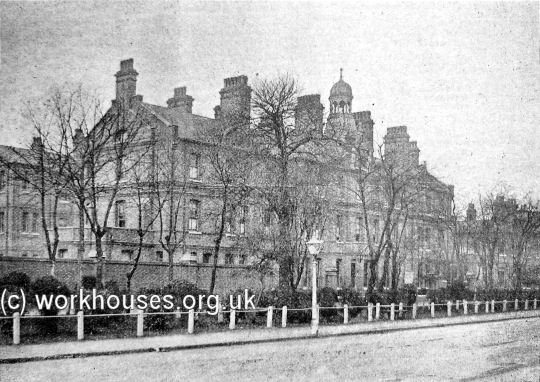
Lewisham workhouse infirmary from the south-east, c.1895.
© Peter Higginbotham.
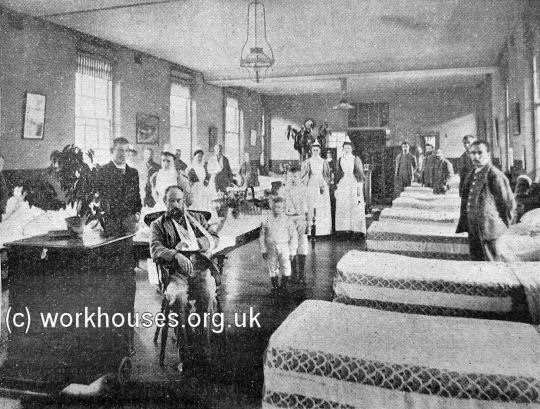
Lewisham workhouse infirmary ward, c.1895.
© Peter Higginbotham.
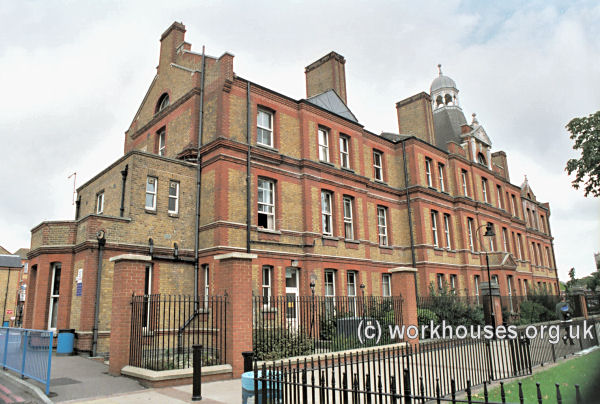
Lewisham workhouse infirmary from the south-east, 2001.
© Peter Higginbotham.
The site layout in 1914 is shown below.
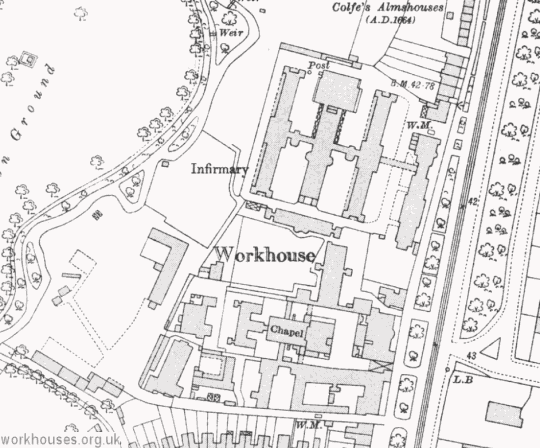
Lewisham workhouse site, 1914.
From 1904, to protect them from disadvantage in later life, the birth certificates for those born in the workhouse gave its address just as 390 High Street Lewisham.
During the First World War, the infirmary served as Lewisham Military Hospital and most of the existing inmates were relocated to other workhouses.
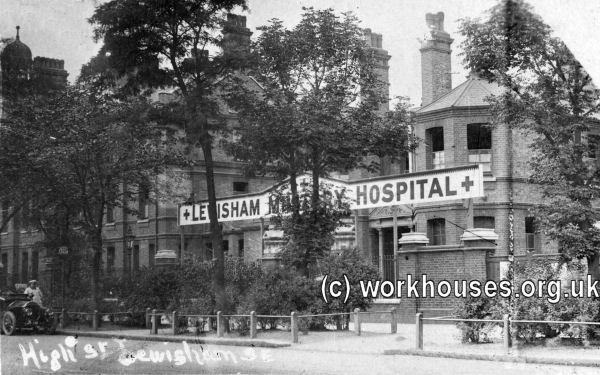
Lewisham Military Hospital from the north-east, c.1916.
© Peter Higginbotham.
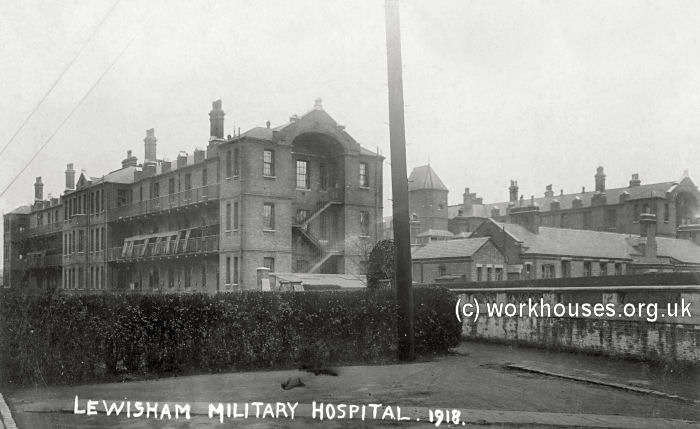
Lewisham Military Hospital from the west, c.1916.
© Peter Higginbotham.
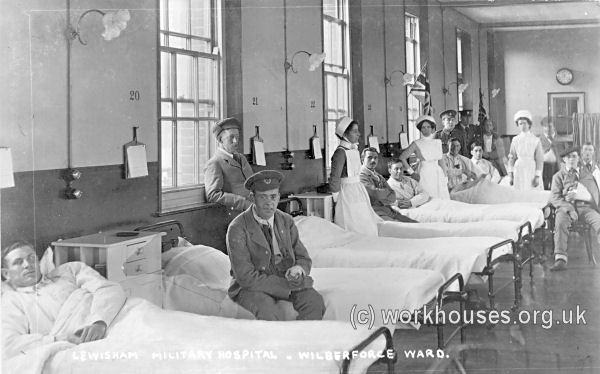
Wilberforce Ward, Lewisham Military Hospital, c.1916.
© Peter Higginbotham.
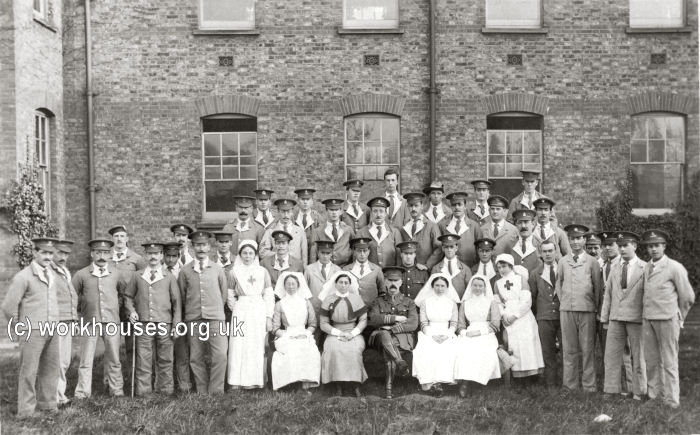
Staff and patients, Lewisham Military Hospital, c.1916.
© Peter Higginbotham.
In March 1920, the whole site was renamed Lewisham Hospital, now known as University Hospital, Lewisham. The 1817 frontage still survives.
Receiving Homes
The Lewisham Union had a children's Receiving Home at 28 Sangley Road, Catford. By the late 1920s, it had relocated to 'Cumberlow', Lancaster Road, South Norwood. The homes dealt with children newly entering the union's care. The Sangley Road premises still exist but the Lancaster Road building has gone.
Staff
Inmates
Records
Note: many repositories impose a closure period of up to 100 years for records identifying individuals. Before travelling a long distance, always check that the records you want to consult will be available.
- London Metropolitan Archives, 40 Northampton Road, London EC1R OHB. Has virtually all the surviving records for the Metropolitan Asylums Board and its instititutions. Search their catalogue at https://search.lma.gov.uk/. Holdings include: Admissions and discharges (1837-1920); Births (1866-1909); Deaths (1883-1915); Creed registers (1869-1920); Guardians' minute books (1836-1930); etc.
Bibliography
- Higginbotham, Peter Workhouses of London and the South East (2019)
- Lewisham Workhouse by Len Wagstaff (1984, in NWKFHS Newsletter)
Links
- None.
Unless otherwise indicated, this page () is copyright Peter Higginbotham. Contents may not be reproduced without permission.


